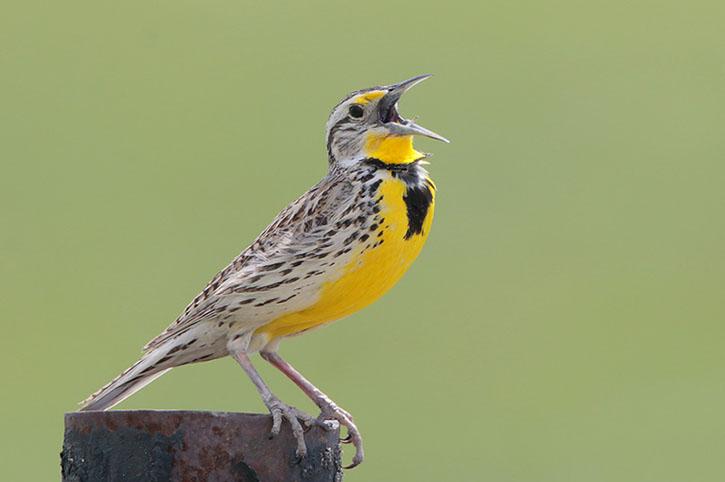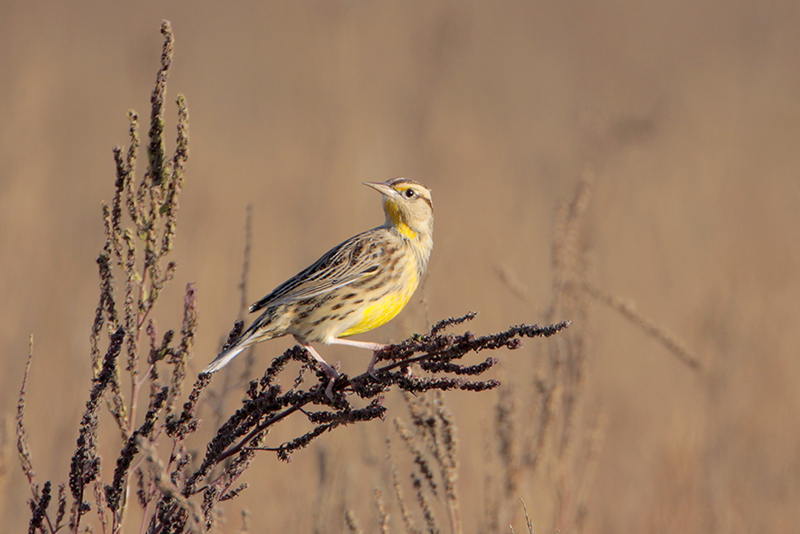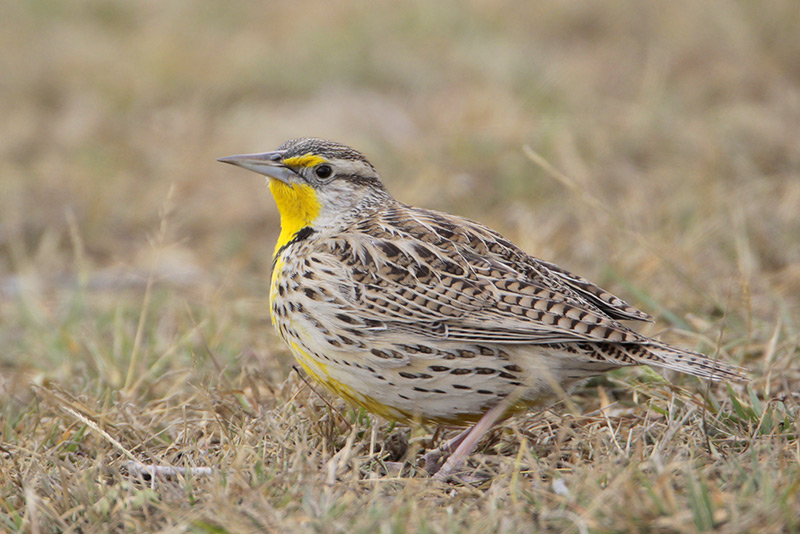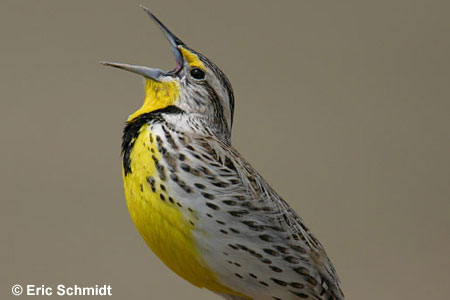
Kansas is a midwestern U.S. state whose terrain consists of plains, gentle hills, pastures, and forests. It’s a larger state with a population of 2.935 million and an 82,278 sq mile size.
Kansas state bird is the Western Meadowlark. These birds can be found throughout the western portions of the United States.
Western Meadowlarks have robust builds and are characterized by their compact bodies and short tails.
On this page
History
The Western Meadowlark (Sturnella neglecta) became the official state bird of Kansas in 1937. It became the state bird following a vote that involved the state’s schoolchildren.
The Kansas Audubon Society organized a survey involving approximately 121,000 schoolchildren across the state, resulting in the Western Meadowlark being selected as the preferred choice for the state bird.

With an impressive 43,895 votes, the meadowlark was the clear winner, surpassing its competitors, the Cardinal and the Bobwhite.
Later, the Kansas legislature enacted a law that officially recognized the Western Meadowlark as the state bird of Kansas.
The Western Meadowlark is also the state bird of Wyoming, North Dakota, Nebraska, Oregon, and Montana.
The exact reason schoolchildren chose the Western Meadowlark is unknown; one plausible explanation could be its association with the sunflower fields seen throughout the state and their vibrant plumage.
The bright yellow coloring on its stomach and chest may have resonated with the children because it strongly resembles sunflowers.
Where can you find them?
Western Meadowlarks are widely distributed across the western and central regions of the United States. Their range extends as far south as Mexico and as far north as southern Canada.
They can be found in the western half of Nebraska, Oklahoma, and Texas in the eastern part of their range.
Western Meadowlarks can be spotted as far east as southern Ontario and Michigan in the northern parts of their range, although they’re not as common in these eastern portions.
Western Meadowlarks prefer to inhabit open grassland, meadows, prairies, and pasture habitats. They can also be found in rural areas like cultivated fields. Overall, regions with shorter grasses are more favorable for these birds.
Fun Facts about Western Meadowlarks
- The Western Meadowlark is the official state bird of multiple states, including Kansas, Nebraska, Montana, Wyoming, and North Dakota.
- Previously, Western Meadowlarks and Eastern Meadowlarks were seen as a single species. However, they are now recognized as separate species and are differentiated mainly by their distinct calls.
- When food is scarce, Western Meadowlarks may resort to consuming roadkill.
- Western Meadowlark chicks’ eyes are closed upon hatching, and their skin is pink.
- Western Meadowlarks are very noisy birds. It’s not uncommon for them to be heard before being seen.
Identification & Behaviour
The Western Meadowlark can be identified by the streaked brown plumage on its upper body and the vibrant yellow plumage on its lower body.
They have a distinct black “V” shape on the breast. It’s short wings and spiky tail with white outer feathers are noticeable during flight.
These birds breed in fields and grasslands across the western portions of North America. During the winter, they inhabit a broader range of open habitats, including agricultural fields and roadsides.

Western Meadowlarks have a striking resemblance to Eastern Meadowlarks. The most reliable way to distinguish the two is through their vocalizations.
Its plumage appears duller and less vibrant in the winter months compared to the Eastern Meadowlark. Additionally, the Western Meadowlark is more likely to gather in flocks and can be found in areas with shorter grass.
Female and male Western Meadowlarks look the same, both have yellow cheeks and throat, with some yellow extending down to their belly, and brownish plumage with white flanks. They look quite small, but their wingspan is 16 inches long.
These birds are typically solitary. They’re often seen in pairs or alone during the breeding season. This songbird is a ground nester, they find shallow depressions and then build their nests out of dry grasses and shrub stems. Their nest may have a grass roof, or even a tunnel leading inside.
However, for the rest of the year, particularly in colder months, they may gather in small flocks. When flying, these birds tend to maintain a low altitude, skimming the top of the grass with swift wing beats.
They do have some predators, such as hawks, coyotes, raccoons, and falcons.
What do Western Meadowlarks eat?
The Western Meadowlark’s diet changes seasonally. During winter and early spring, their diet primarily consists of grains, while insects (such as grasshoppers, caterpillars beetles, and other bugs) become a predominant food source throughout the breeding season. In the fall, grain seeds, weed seeds, and berries are their primary food source.
Like the Eastern Meadowlark, this species engages in ground foraging.
This process involves the Western Meadowlark inserting its closed bill into the ground or a clump of grass and opening its beak to access the food.
This feeding behavior is known as gaping and is observed in other members of the Blackbird family. For example, Common Grackles exhibit this behavior as well.
Call
Meadowlarks have an extensive array of calls and songs. These sounds are used for various purposes, such as claiming territory, attracting mates, maintaining social contact, and warning of potential threats.
Both males and females vocalize, but the male’s loud and intricate territorial song stands out as the most recognizable sound of these birds.
The male’s song is a clear signal to potential rivals that the territory is occupied by a resident male who is prepared to defend his space and any females occupying that space. Their songs typically last between 1 to 2 seconds and are often delivered from high perches such as shrubs, rocks, and fence posts scattered throughout their territory.
Each male boasts a collection of 6 to 9 distinct territorial song types. They typically produce a call that repeats before transitioning to another. The act of switching songs often occurs in response to an intruder.

Frequently Asked Questions
What is the state bird of Kansas?
The state bird of Kansas is the Western Meadowlark.
Why is the Western Meadowlark the state bird of Kansas?
The reason why the Western Meadowlark was chosen to be the state bird of Kansas is not known. However, it’s theorized that it’s because of the bird’s yellow plumage, which has a strong resemblance to sunflowers. Sunflowers are abundant in the state.
When did Kansas choose its state bird?
Kansas officially chose the Western Meadowlark as its state bird in 1937. It became the state bird following a vote by the Kansas Audubon Society, which involved the state’s schoolchildren.

